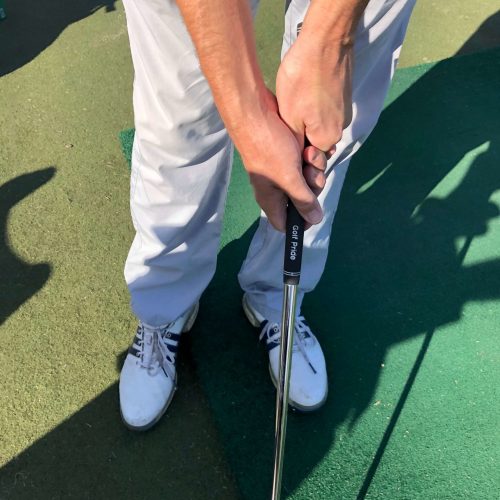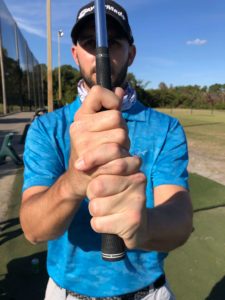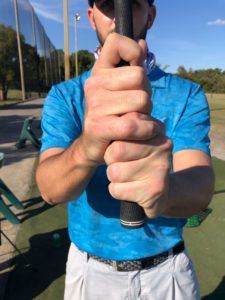How to properly grip a golf club

A proper golf grip is essential to having a great swing. There’s no getting around that simple statement. A great golf grip will help improve your ball striking errors, make you more consistent, and give you an all-around better golf game. Whether you’re teeing off down a tight fairway at Augusta, or standing over a 3 foot slider, you need to know how to correctly put your hands on the club.
A lot of people overlook the golf group. One of the best ball strikers of all time said that golf begins with a good grip his name is Ben Hogan.
Over your golf career are you a grip the golf club thousands and thousands of times. Maybe even more than that. In order to deliver a square club face on the back of the bar every time, you’ll need to figure out the proper golf grip.
A great grip is the foundation to a great player in low scores.
some coaches won’t let a student even hit a ball until they can show that they can grip the club correctly and have a solid golf stance. This is why we find this article so important that you understand how to properly grip a golf club. Let’s get started.
How do you grip a golf club for beginners?
1. Let’s check your current grip
Let’s dive right in and start showing you the best ways to hold your golf club on the golf course.
Hold the grip on your golf club in your fingers.
Hold the golf club like you hold your steering wheel of your car. You don’t choke the steering wheel when you’re turning.
How do you grab the club when you first pick it up? How do you hold the club? What position are your fingers in? Are you squeezing the club tight or loose? How confident that you’re going to hit a great shot right then and there?
Do you think there’s any room for improvement? Awesome! Then you’re ready to learn now. Let’s go!
What is the Best Grip Size For You?
Every single golf club has a rubberized grip on them. Typically your club will have a standard size. But that doesn’t always mean that it’s the right grip size for you. Different size grips are out there and they’re out there for a reason. It could be that you need to find some new ones. For now let’s stick with the ones you have. Read the rest of this guide to test out your grip.
If you find that you always pull or a slice the ball when you are playing golf… You may very well need to consider re-gripping your golf clubs. Your golf shop can advise you on a suitable size. Just go in and ask them to size you for the correct grip and show you the different options. If you have large hands you probably need large groups. If you have small hands the grips you have are probably fine.
2.Hand Positioning
It’s time to grab your club and start getting your grip perfected.
Always grab your club with your weaker hand first (this would be your left hand for a right handed golfer). Rotate your hand over so that you can see two knuckles on your left hand and that the V shape that your index finger and thumb have created point towards your right shoulder.
Most tour pros allow for a bout a half of an inch at the end of the golf grip when they are properly gripping the club.
Your left thumb should go directly down the shaft. Now take your right hand and grip the club how you naturally would grip it. Now make sure your right thumb is sitting on top of your left thumb, however that feels comfortable. With both arms facing downward.
If this task is a little bit confusing and you are not confident that your hands are in the correct position, don’t worry. There are special grips that you can purchase to help you find the proper grip.
- Let’s draw some lines!
If you’re like most golfers you carry a sharpie or a marker pen in your golf bag. If you’re not sure if you have the proper grip or not you can draw lines on your glove at the correct angle to help. It will show you where the club should go on your fingers each and every time until you have it memorized.
5. Interlocking vs overlapping golf grip


The last piece to the puzzle… Is to figure out whether you want to link your hands together or overlap them. Some players In Interlock, some players overlap.
Some players use the interlocking position because it allows for more hinging of the wrist and gives you a more solid overall grip. But, at the end of the day… You should definitely go with whatever feels best to you and whatever gives you the best chance to strike the ball solidly every time
- Grip pressure
Tension is not your friend when talking about the proper grip pressure. Do you want to hold a golf club like a baby bird that you don’t want to let fly away. The proper golf grip has no tension in the forearms and has a nice solid connection from hand to grip. If you feel your forearms tense up when you address the ball, you are gripping the club much too tight. Swing the club like that and there’s probably no chance you’re going to hit a good shot.
Sometimes a nice little waggle or two helps remove the tension in your forearms. You’ll notice players like Jason Dufner and Daniel Berger who do this a lot.
- Start things in the center first
How much you rotate your left hand when you were gripping the golf club depends on how strong your grip is. If you can see more than two knuckles on your hand when looking down, that is considered a strong grip and will promote a closed club face at impact. Adversely, if you can only see one knuckle in your hand is rotated more to the left that is considered a soft grip and which will promote an open club face at impact.
So tinker with your left hand position, since that is your lead arm and hit different shots on the golf range and determine what is most comfortable.
